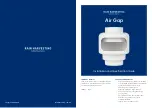
System 3
7-37
MS4/MS16 Stimulus Isolator
setting any channel in a bank to both Stimulate and Reference mode turns off that
entire bank of channels.
An ACC16 AC Coupler is supplied with all MS4/MS16 modules and may be
connected directly to the Stim Output connector to block any DC current bias present
on the Stim Output lines (this problem primarily affects researchers using electrodes
with impedance of more than ~100 kOhms) when set in stimulate mode.
Note:
When using the ACC16 you will NOT be able to deliver the MAXIMUM current.
Stim
Lights
A Stim Light (one for each channel) indicates that a Stim Output channel is in use
as a stimulus output. The Stim Lights are located above the Stim Output connector
and are numbered 1 - 16, to indicate the active channel number. The LEDs will
flash once every three seconds to indicate any bank of channels that has been
powered off.
Ref
Lights
A Ref Light (one for each channel) indicates that a Stim Output channel is in use
as a reference. The Ref Lights are located above the Stim Output connector and are
numbered 1 - 16, to indicate the active channel number.
Status
Lights
Sync:
Flashes once a second when the stimulator is not connected to
a base station and glows steady when it is correctly connected.
Stim Ref:
When lit, indicates that the stimulator has been configured to use
a global reference.
Battery:
When lit, indicates when the stimulator's onboard battery is low.
The battery voltage decreases rapidly once the battery low light
is on.
Fast:
charging
Slow:
low battery
High Voltage:
When lit, indicates that the stimulator is correctly connected to
the designated Battery Pack.
Solid:
correct working voltage
Flashing:
low voltage
Digital
Output
(Control
Outputs)
The Control Output connector provides access to the stimulator’s 16 channels of
Word addressable digital output. These outputs can control the relays on the SH16
switching headstage or other digital output device (maximum current 40 mA,
maximum voltage 3.3 Volts).
Summary of Contents for RZ2
Page 1: ...System 3 Manual Updated 5 8 18...
Page 7: ...Part 1 RZ Z Series Processors...
Page 8: ...1 2 System 3...
Page 40: ...1 34 System 3 RZ5P Fiber Photometry Processor...
Page 56: ...1 50 System 3 RZ6 Multi I O Processor...
Page 68: ...1 62 System 3 RZ5 BioAmp Processor...
Page 96: ...1 90 System 3 RZ UDP Communications Interface...
Page 97: ...Part 2 Data Streamers...
Page 98: ...1 2 System 3...
Page 122: ...2 26 System 3 RS4 Data Streamer...
Page 133: ...Part 3 RX Processors...
Page 134: ...3 2 System 3...
Page 156: ...3 24 System 3 RX6 Multifunction Processor...
Page 177: ...Part 4 RP Processors...
Page 178: ...4 2 System 3...
Page 184: ...4 8 System 3 RP2 1 Real Time Processor...
Page 199: ...Part 5 RM Mobile Processors...
Page 200: ...5 2 System 3...
Page 209: ...Part 6 Preamplifiers...
Page 210: ...1 2 System 3...
Page 238: ...6 30 System 3 PZ5 NeuroDigitizer...
Page 266: ...6 58 System 3 PZ5M Medically Isolated NeuroDigitizer...
Page 274: ...6 66 System 3 PZ2 PreAmp...
Page 296: ...6 88 System 3 RA16PA RA4PA Medusa PreAmps...
Page 315: ...Part 7 Stimulus Isolator...
Page 316: ...1 2 System 3...
Page 334: ...7 20 System 3 IZ2 IZ2H Stimulator...
Page 346: ...7 32 System 3 IZ2M IZ2MH Stimulator...
Page 368: ...7 54 System 3 MS4 MS16 Stimulus Isolator...
Page 369: ...Part 8 Video Processor...
Page 370: ...1 2 System 3...
Page 388: ...8 20 System 3 RV2 Video Processor...
Page 406: ...8 38 System 3 RVMap Software for RV2...
Page 407: ...Part 9 MicroElectrode Array Interface...
Page 408: ...1 2 System 3...
Page 415: ...Part 10 High Impedance Headstages...
Page 416: ...1 2 System 3...
Page 442: ...10 28 System 3 ZIF Clip ZCD Digital Headstages...
Page 474: ...10 60 System 3 SH16 Switchable Headstages...
Page 475: ...Part 11 Low Impedance Headstages...
Page 476: ...1 2 System 3...
Page 483: ...Part 12 Adapters and Connectors...
Page 484: ...1 2 System 3...
Page 512: ...12 30 System 3 Splitters...
Page 519: ...Part 13 Microwire Arrays...
Page 520: ...1 2 System 3...
Page 526: ...13 8 System 3 ZIF Clip Based Microwire Arrays...
Page 531: ...System 3 13 13 Suggestions for Microwire Insertion...
Page 532: ...13 14 System 3 Suggestions for Microwire Insertion...
Page 545: ...Part 14 Attenuator...
Page 546: ...1 2 System 3...
Page 558: ...14 14 System 3 PA5 Programmable Attenuator...
Page 559: ...Part 15 Commutators...
Page 560: ...1 2 System 3...
Page 578: ...15 20 System 3 ACO32 ACO64 Motorized Commutators...
Page 579: ...Part 16 Transducers and Amplifiers...
Page 580: ...1 2 System 3...
Page 586: ...16 8 System 3 MF1 Multi Field Magnetic Speakers...
Page 592: ...16 14 System 3 EC1 ES1 Electrostatic Speaker...
Page 597: ...System 3 16 19 HB7 Headphone Buffer...
Page 598: ...16 20 System 3 HB7 Headphone Buffer...
Page 601: ...System 3 16 23 MA3 Microphone Amplifier Frequency Response Diagram...
Page 602: ...16 24 System 3 MA3 Microphone Amplifier...
Page 604: ...16 26 System 3 MS2 Monitor Speaker...
Page 610: ...16 32 System 3 SA8 Eight Channel Power Amplifier...
Page 614: ...16 36 System 3 FLYSYS FlashLamp System...
Page 619: ...Part 17 Subject Interface...
Page 620: ...1 2 System 3...
Page 659: ...Part 18 Signal Handling...
Page 660: ...1 2 System 3...
Page 691: ...Part 19 PC Interfaces...
Page 692: ...19 2 System 3...
Page 697: ...System 3 19 7 PO5 PO5e Optibit Interface Dimensions PO5e PO5...
Page 700: ...19 10 System 3 UZ3 USB 3 0 Interface for Optibit...
Page 704: ...19 14 System 3 LO5 ExpressCard to zBus Interface...
Page 707: ...Part 20 The zBus and Power Supply...
Page 708: ...20 2 System 3...
Page 714: ...20 8 System 3 ZB1 Device Caddie and PS25F Power Supply...
Page 715: ...Part 21 System 3 Utilities...
Page 716: ...21 2 System 3...
Page 728: ...21 14 System 3 Corpus System 3 Hardware Emulator...
Page 729: ...Part 22 Computer Workstation...
Page 730: ...22 2 System 3...
















































